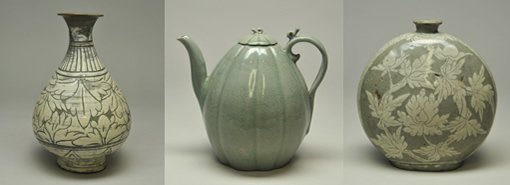Soul of simplicity
Seven centuries of Korean ceramics

Bottle with sgraffito design of peonies, Joseon dynasty, middle of 15th century, Buncheong ware. Melon-shaped ewer, Goryeo dynasty, 12th century, Celadon. Flask with sgraffito design of peony, Joseon dynasty, middle of 15th century, Buncheong ware, The Museum of Oriental Ceramics, Osaka. Gifts of the Sumitomo group.
In response to the increased interest in Korean art in culture, a special exhibition – Soul of simplicity: seven centuries of Korean ceramics – will open on 8 February 2013 to coincide with the start of the seollal festivities, or Lunar New Year in Korea.
Characterised by clarity of forms, understated decorations and subtle yet luminous colour glazes, ceramics have long been appreciated as one of the most significant artistic contributions of the Korean peninsula, said Dr Khanh Trinh, curator.
The 38 objects in this show are drawn from the outstanding collection of Korean ceramics of the Museum of Oriental Ceramics, Osaka (MOCO). Founded in 1982 by the city of Osaka to house the extensive Ataka collection of Korean and Chinese ceramics, MOCO has since expanded its collecting and research activities and is today arguably one of the most recognised centres for the display and study of oriental ceramics worldwide.
The selection chosen for Sydney focuses on the two major periods during which Korean ceramic art has reached its peak, namely the Goryeo (918-1392) and Joseon (1392-1897) dynasties. The main type of ceramics produced during the Goryeo period was celadons, characterised by harmonious, sensous forms and a distinctive luminous bluish green glaze. Initially strongly influenced by Chinese celadons of the Song dynasty (960-1279), by the 12th century, Goryeo potters had perfected the glazing technique to the point that Chinese envoys reported enthusiastically that the Korean celadons were ‘the first under heaven’ with glazes that had the ‘radiance of jade and clarity of water’. One of the most important inventions in Goryeo ceramics was the sanggam (inlay) surface decoration. In this technique, the designs are first carved or incised on the dry clay body and then filled in with black and/or white slip before a translucent glaze is applied and the vessel fired. Sanggam celadons epitomise the unique technical excellence of Goryeo ceramic culture.
Joseon period ceramics can roughly be divided in two basic types: the robust stoneware called Buncheong and fine white porcelain either plain or decorated with underglaze painting. Flourishing only during the 15th and 16th centuries, Buncheong ware continued the techniques of inlay and underglaze painting in iron pigment or white slip that were first used in Goryeo ceramics. The decoration was frequently simplified by densely stamped patterns that are filled with white slip only, or by applying bold, abstract brushstrokes of white slip or iron pigment on the grey clay body. Plain white porcelain dishes, bowls, bottles and jars of severely unpretentious yet elegant forms were the preferred ware of the royal court and social elites from the 16th century onwards. Used as special tableware or as ceremonial or burial vessels, the plain white ware reflected the purist and minimalist aesthetics associated with neo-Confucianism, which was introduced as the state ideology of the Joseon dynasty.
On view
8 Feb 2013 – 21 Apr 2014
Art Gallery of New South Wales
Art Gallery Road, The Domain, Sydney
Admission
Free
Media contact
Susanne Briggs
Tel 02 9225 1791
Mob 0412 268 320
susanne.briggs@ag.nsw.gov.au
